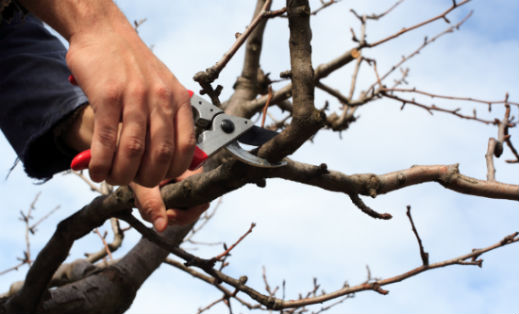
By knowing the basics about tree trimming and tree pruning, you may be able to handle the majority of this kind of work yourself. There are a variety of great trimming tips and pruning techniques that can help keep your trees in excellent shape. With the right knowledge and equipment, you can prune your trees as necessary to maintain their appearance and health and to eliminate potentially dangerous dead branches and other common issues.
While there are many tree trimming techniques out there, if you want to this yourself you only need to concern yourself with the basics to keep things in order. Alternatively, you can hire a professional and not think twice about it! Read our guide below for more information.
Reasons to Trim or Prune a Tree
Trees are generally trimmed for one of three purposes: aesthetics, safety or health. For example:
- Aesthetics – Pruning a tree effectively helps to maintain its shape and appearance. However, you shouldn’t try to impose an unnatural shape or size on a tree. The amount of trimming and pruning that will be needed could seriously damage it.
- Safety – Dead or broken branches and limbs can fall off at any time, which is a serious safety hazard. If the branches of a tree obstruct your vision while driving, they should be trimmed away. Finally, tree limbs and branches occasionally grow too close to utility lines. Contact the utility company to handle such issues.
- Health – It is sometimes possible to save an infected tree by strategically pruning away affected branches and limbs. Thinning the crown of a tree improves airflow, which can be very beneficial. If branches are crossing or rubbing together, they should be trimmed, or removed so that they don’t fall unexpectedly.
General Tree Trimming Tips
- It’s almost always best to trim or prune a tree during its dormant season. Although you can technically prune a pine tree at any time, it is still better to do so when it is dormant. The only exception is when a hazard exists.
- Be conscientious about the size of the branch that you are going to remove. If it is less than five centimeters in diameter, removing it is fine. If it is between five and 10 centimeters in diameter, you might not want to do it. If it is more than 10 centimeters in diameter, you should only do so if you have a really good reason.
- Only trim branches that have weak, V-shaped, narrow angles. Retain branches that have strong, U-shaped angles.
- When pruning is complete, the ratio of living crown to tree height should be two-thirds.
- Try to prune away branches when they are young. They are much easier to manage at that point, and the risk of leaving nasty scars is much lower.
- Don’t trim a branch too close or too long. You shouldn’t leave a large stub or remove the branch collar.
Tree Pruning Tips
The following tips and techniques will help guide you if you’re planning on pruning a tree or if you just want to educate yourself about typical tree trimming care and maintenance techniques.
Crown Thinning
 If you need to thin the crown of a tree, you should keep the following tips and techniques in mind:
If you need to thin the crown of a tree, you should keep the following tips and techniques in mind:
- Keep lateral branches as evenly spaced as possible, especially on young trees.
- Prune away branches that cross other branches or run against them.
- Never remove more than one-fourth of a living crown at once. If you need to remove more than that, spread it out over a number of years.
Crown Raising
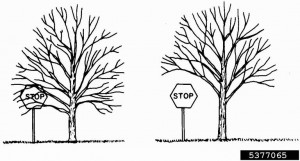
- To provide clearance for pedestrians and for other reasons, you can raise the crown by carefully pruning the tree. Maintain live branches on at least two-thirds of a tree’s height. If you remove too many branches near the bottom half, the tree may not be able to develop a strong stem.
Crown Reduction
- If you need to remove more than half of the foliage from a branch, just remove the whole branch.
- Only reduce the crown of a tree if it’s really necessary. Prune lateral branches that are at least one-third of the diameter of the stem that needs to be removed.
Tree Trimming Techniques
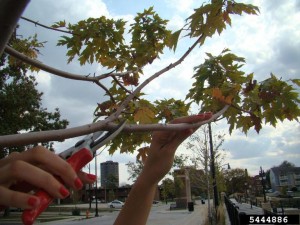 Here are a few tree pruning techniques to keep in mind:
Here are a few tree pruning techniques to keep in mind:
- Before making a cut, look for the branch collar, which grows from the stem tissue at the bottom base of the branch. Look for the branch ridge, which is on the upper surface and is parallel to the branch angle at the stem.
- Always cut outside the branch bark ridge and angle your cut down and away from the stem. Take care not to injure the branch collar.
- Use the same technique to prune dead branches and living branches.
- If a stem is too long, use the three-cut technique: Make a notch on the side of the stem that faces away from the branch that’s being retained; make the second cut inside the crotch of the branch and above the branch ridge; the third cut will remove the stub by cutting through the stem parallel to the branch bark ridge.
Keep these tricks and techniques from this tree pruning guide in mind before taking on the task of pruning and trimming your trees.
How Much Does Tree Trimming Cost?
If you want to keep your landscaping attractive, you should consider having your your trees trimmed and pruned. Trimming or pruning helps remove dead or broken limbs and helps keep your tree healthy. The cost of tree trimming depends on a variety of factors, but is especially dependent on whether you do it yourself or hire a professional. Learn more with our Tree Trimming Cost & Prices Guide. For a list of questions to ask a contractor, see our Tree Cutting & Trimming Service Guide.
**Some images courtesy of International Society of Arboriculture.

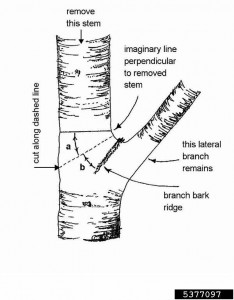
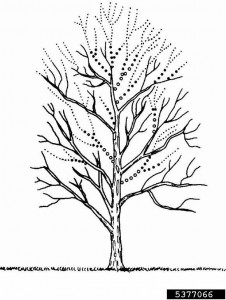
jeff padgett
your web site has been helpful i am being trained to be a climber down here in savannah georgia
Jackie
My husband wants the young trees still growing lower branches cut so he can mow around them easier. Is this a good idea. I have trimmed the small branches as the tree grows but the branches are getting thicker so I am leary to trim them.
Barb McCartney
I have two dieciduous trees that lost their leaves on a number of branches. There are a few branches left that have leaves and look healthy. Can I trim away the barren branches? Also, one of the trees lost everything on the top of the tree, can I remove the leader branch?
evan peter
Barb,
If a limb loses all its leaves during the spring or summer, then that typically indicates the limb has died. It is best to remove any dead limbs back to where the dead limb branches off of a live limb. Make sure to remove the limb using an under-cut then a top cut to avoid peeling the bark, followed by a finishing cut leaving approximately a half inch collar for proper healing. I am concered that one of your trees has lost all of the leaves at the top of the canopy. This could indicate a tree that is dying. I would recommend you have a certified arborist from a company like happytreeserviceofaustin.com take a look at your trees to ensure there is not some underlying issue that needs to be addressed. Good luck!
Sheila
How do you get rid of sucker limbs that come out from the bottom part off the tree trunk? We keep them pruned off, but they only return with a vengance.
Andrea Davis
Sheila,
Instead of pruning them, you need to get down to their roots and physically tear them out even if it means removing some soil in the process. Tearing them out means the buds will come out too, which reduces the possibility of them reappearing next year. You can also treat the area with chemicals like Roundup Tree Stump & Rootkiller or Bayer Tree Stump Killer, but you need to make sure to pull the sucker root as far away from the main tree as possible to avoid the main roots being damaged. It’s probably safer for your tree to tear suckers out than to chemically treat the problem.
Justin Mathis
I ordered 2 fruit trees and this is there second blooming season. I missed pruning in the winter and afraid they may have overgrown. Can I have my service prune them in the spring or should I wait until they are dormant again in the winter? I like to check your site before I do or hire anyone do anything, thanks
allen
I have been trimming a four limb tree for a number of years. It has a crown on top of each where new growth come back each year I was wondering if cutting below the crown ,would it send out new limbs? Thanks